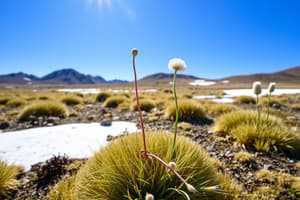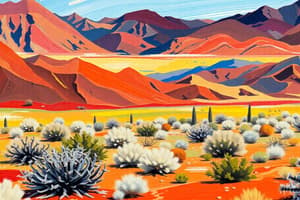Podcast
Questions and Answers
Where in the world is an example of the tundra ecosystem?
Where in the world is an example of the tundra ecosystem?
Northern North America, northern Europe, and northern Asia.
What describes the geography of the tundra?
What describes the geography of the tundra?
- Treeless (correct)
- Tropical climate
- Dense forests
- Rivers and lakes
What climate characteristics define the tundra?
What climate characteristics define the tundra?
Coldest of the biomes, average temperature -18 degrees F.
What are the factors that will affect the tundra Arctic?
What are the factors that will affect the tundra Arctic?
What are the abiotic factors of the tundra Arctic?
What are the abiotic factors of the tundra Arctic?
What are the biotic factors of the tundra Arctic?
What are the biotic factors of the tundra Arctic?
What are the key producers of the tundra Arctic?
What are the key producers of the tundra Arctic?
What are the key consumers of the tundra Arctic?
What are the key consumers of the tundra Arctic?
What niche does the Arctic fox occupy?
What niche does the Arctic fox occupy?
What is one problem in the Arctic tundra?
What is one problem in the Arctic tundra?
What are the causes of the problems in the Arctic tundra?
What are the causes of the problems in the Arctic tundra?
What are the key abiotic factors involved in the problems in the tundra Arctic?
What are the key abiotic factors involved in the problems in the tundra Arctic?
What are the key biotic factors involved in the problems in the tundra Arctic?
What are the key biotic factors involved in the problems in the tundra Arctic?
Match the following in the Arctic food chain:
Match the following in the Arctic food chain:
Flashcards are hidden until you start studying
Study Notes
Tundra Ecosystem Overview
- Located in northern North America, Europe, and Asia.
- Characterized as a treeless region with a permanently frozen layer of soil called permafrost.
Geography and Climate
- Tundra ecosystems have harsh climates with extreme cold, averaging -18 degrees Fahrenheit.
- Winters can be extremely cold, with temperatures dropping to -34 degrees Fahrenheit.
- Short summer days with minimal rainfall and strong winds.
Abiotic and Biotic Factors
- Abiotic factors include strong winds, cold temperatures, permafrost, and limited rainfall.
- Biotic factors involve competition among animals for food, vegetation structure, and the presence of predators.
Key Producers
- Primary producers in the Tundra include phytoplankton, ice algae, mosses, lichens, low-growing plants, grasses, and shrubs.
Key Consumers
- Notable consumers include caribou, deer, arctic hares, and lemmings, which are essential for energy transfer within the ecosystem.
Arctic Fox Niche
- The Arctic fox serves as both a consumer and predator, preying on small mammals while also being a food source for larger predators.
Environmental Issues
- Global warming presents significant challenges to the Arctic tundra, leading to environmental degradation.
- The greenhouse effect exacerbates warming, causing increased temperatures and changes in ecosystem dynamics.
Impact of Global Warming
- Rising temperatures contribute to the melting of snow and ice and thawing permafrost.
- This leads to the decline of first-level consumers and shifts in species populations, potentially causing a chain reaction affecting the entire food web.
Food Chain Dynamics
- The food chain in the tundra includes relationships like polar bears preying on arctic foxes, which in turn consume lemmings that feed on lichens, highlighting interconnectedness in the ecosystem.
Studying That Suits You
Use AI to generate personalized quizzes and flashcards to suit your learning preferences.




